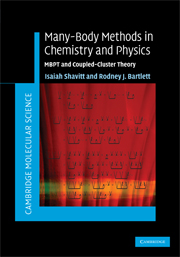Book contents
- Frontmatter
- Contents
- Preface
- 1 Introduction
- 2 Formal perturbation theory
- 3 Second quantization
- 4 Diagrammatic notation
- 5 Diagrammatic expansions for perturbation theory
- 6 Proof of the linked-diagram theorem
- 7 Computational aspects of MBPT
- 8 Open-shell and quasidegenerate perturbation theory
- 9 Foundations of coupled-cluster theory
- 10 Systematic derivation of the coupled-cluster equations
- 11 Calculation of properties in coupled-cluster theory
- 12 Additional aspects of coupled-cluster theory
- 13 The equation-of-motion coupled-cluster method for excited, ionized and electron-attached states
- 14 Multireference coupled-cluster methods
- References
- Author index
- Subject index
8 - Open-shell and quasidegenerate perturbation theory
Published online by Cambridge University Press: 06 January 2010
- Frontmatter
- Contents
- Preface
- 1 Introduction
- 2 Formal perturbation theory
- 3 Second quantization
- 4 Diagrammatic notation
- 5 Diagrammatic expansions for perturbation theory
- 6 Proof of the linked-diagram theorem
- 7 Computational aspects of MBPT
- 8 Open-shell and quasidegenerate perturbation theory
- 9 Foundations of coupled-cluster theory
- 10 Systematic derivation of the coupled-cluster equations
- 11 Calculation of properties in coupled-cluster theory
- 12 Additional aspects of coupled-cluster theory
- 13 The equation-of-motion coupled-cluster method for excited, ionized and electron-attached states
- 14 Multireference coupled-cluster methods
- References
- Author index
- Subject index
Summary
Formal quasidegenerate perturbation theory (QDPT)
As is well known, ordinary Rayleigh–Schrödinger perturbation theory breaks down when applied to a state that is degenerate in zero order, unless spin or symmetry restrictions eliminate all but one of the degenerate determinants from the expansion. The breakdown is due to singularities arising from the vanishing of denominators involving differences in energy between the reference determinant and determinants that are degenerate with it. Even when exact zero-order degeneracies are not present but two or more closelying zero-order states contribute strongly to the wave function, as is the case for many excited states or in situations involving bond breaking, the RSPT expansions tend either to diverge or to converge very slowly.
These problems commonly arise in the case of open-shell states because different distributions of the open-shell electrons among the open-shell orbitals, all with the same or very similar total zero-order energies, are possible. Many open-shell high-spin states can be treated effectively with singlereference- determinant methods using either unrestricted or restricted openshell HF reference determinants because the spin restrictions exclude alternative assignment of the electrons to the open-shell orbitals; however, low-spin states, such as open-shell singlets, require alternative approaches.
Several common series-extrapolation techniques can be used to speed up the convergence of a perturbation expansion or to obtain an approximate limit of a divergent series. The results of such an extrapolation usually improve as more of the early terms of the series become available. Approaches based on Padé approximants (closely related to continued fractions) have been applied in some studies (e.g. Reid 1967, Goscinski 1967, Brändas and Goscinski 1970, Bartlett and Brändas 1972, Bartlett and Shavitt 1977b, Swain 1977).
Information
- Type
- Chapter
- Information
- Many-Body Methods in Chemistry and PhysicsMBPT and Coupled-Cluster Theory, pp. 185 - 250Publisher: Cambridge University PressPrint publication year: 2009
